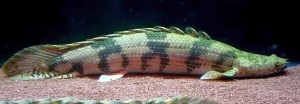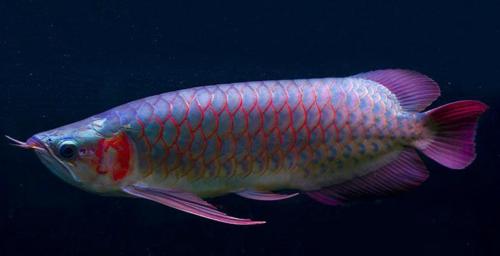Bichirs (Polypteridae) are sometimes referred to by tropical fish keeping enthusiasts as the Dragon Bichir, Dragon Fin, Dinosaur Fish, or Dragon Fish. The name has probably derived from their “dragon like” appearance.
Bichirs are a primitive ray-finned fish that are found in the swampy, shallow floodplains and estuaries of the Nile River system in tropical Africa and are in the same family (Polypteridae) as reedfish and ropefish.
Bichirs are elongated, eel like fish that have from 7 to 18 small dorsal “finlets” in lieu of the single dorsal fin that most ray-finned fish posses. Each of the small finlets have double edged tips and are the only ones with actual spines.
Except for their pectoral fins, which are fleshy and similar to the lobe-finned fishes, the Bichir is covered with thick trapezoidal scales.
The jaw structure of the Bichir is similar to that of a frogs, and they have a pair of slit like openings called spiracles that they use to breath air through a pair of lungs that are connected to their esophagus by a glottis. They posses both a modified paired swim bladder that has the function of “lungs”, as well as gills to breathe. The right side of their swim bladder is larger than the left and is used for breathing atmospheric air.
In poorly oxygenated water, Bichirs will often travel on land for short periods using their muscular pelvic fins but because their bodies must remain moist, they cannot stay out of water for extended periods. These fish can actually drown if denied access to atmospheric oxygen.
All Bichirs are nocturnal opportunistic feeders that have poor eyesight and an excellent sense of smell. In their natural habitat they come out from their hiding places at night to feed on small fish, invertebrates, crustaceans, worms, and insects. In an aquarium environment they should only be housed with larger peaceful fish that they cannot get into their mouths. These fish will eat anything up to their own size.
Depending on the species, Bichirs can grow quite large and frequently outgrow their surroundings. Because of their size, they should be housed in as large a tank as possible for their maximum size. The chart below describes the species and subspecies of Polypterus along with their maximum known size.
| Scientific name | Common name(s) | Size | Origin |
|---|---|---|---|
| Polypterus ansorgii | Guinean bichir | 11″ (28cm) | West Africa (Guinea) |
| Polypterus (bichir) bichir | Nile bichir | 27″ (68cm) | Nile, Cameroon, Ethiopia, Ghana |
| Polypterus (bichir) katangae | 18″ (45cm) | Central Africa (Katanga region) | |
| Polypterus (bichir) lapradei | 24″ (60cm) or more | Most of West Africa | |
| Polypterus delhezi | Armoured / Banded bichir | 14″ (35cm) | Central Africa: Congo river, Upper and middle Congo |
| Polypterus endlicheri congicus | Congo bichir | 39″ (97cm) | Congo, Lake Tanganyika |
| Polypterus endlicheri endlicheri | Red / Saddled bichir | 24″ (60cm) or more | Nigeria, Lake Chad, White Nile |
| Polypterus ornatipinnis | Ornate bichir | 24″ (60cm) | Central and East Africa: Congo river basin, Lake Tanganyika |
| Polypterus palmas buettikoferi | 14″ (35cm) | West Africa | |
| Polypterus palmas palmas | Marbled bichir | 12″ (30cm) | Congo, Liberia, Sierra Leone, Guinea |
| Polypterus palmas polli | Poll’s bichir | 12″ (30cm) | W. & Central Africa, Congo River |
| Polypterus retropinnis | West African / Speckled bichir | 13″ (33cm) | West and Central Africa |
| Polypterus senegalus meridionalis | 28″ (70cm) | Central Africa | |
| Polypterus senegalus senegalus | Senegal bichir | 16″ (40cm) | Africa: East, West and central |
| Polypterus teugelsi | 16″ (40cm) | Cameroon | |
| Polypterus weeksii | Mottled / Week’s / Fat-Headed bichir | 16-24″ (40-60cm) | Congo |
In the aquarium hobby, many tropical fish keeping enthusiasts find the Bichir to be an extremely popular fish.
Despite the fact that they are predators and spend a great deal of time lying on the bottom of the tank, it is understandable why so many enthusiasts keep them. They are relatively easy to maintain and can tolerate a wide variety of water conditions, and are extremely long lived.
They do make good tank mates with many of the larger species that they are unable to eat, and although they are unpredictable with smaller fish, they are usually passive towards their larger tank mates.
In an aquarium environment that is properly maintained, they can easily live well over 10 years.
Feeding Bichirs is usually not a challenge. Being carnivores they prefer a varied diet of live foods such as small worms, ghost shrimp, tubifex, chopped beef heart, mussels, and insects. However, they will also eat prepared dry foods like Krill
or shrimp pellets
, as well as most other freeze dried and frozen meaty foods.





